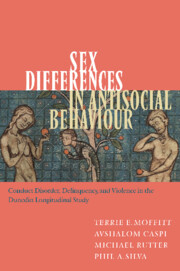 Sex Differences in Antisocial Behaviour
Sex Differences in Antisocial Behaviour Book contents
- Frontmatter
- Contents
- List of figures
- List of tables
- Preface
- Acknowledgements
- 1 Introduction
- 2 The Dunedin Multidisciplinary Health and Development Study
- 3 Sex differences in the amount of antisocial behaviour: dimensional measures
- 4 Sex differences in the prevalence of antisocial behaviour: categorical diagnostic measures
- 5 Sex differences in physical violence and sex similarities in partner abuse
- 6 Sex and the developmental stability of antisocial behaviour
- 7 Sex and the age of onset of delinquency and conduct disorder
- 8 Sex effects in risk predictors for antisocial behaviour: are males more vulnerable than females to risk factors for antisocial behaviour?
- 9 Sex effects in risk predictors for antisocial behaviour: are males exposed to more risk factors for antisocial behaviour?
- 10 Can sex differences in personality traits help to explain sex differences in antisocial behaviour?
- 11 Sex and comorbidity: are there sex differences in the co-occurrence of conduct disorder and other disorders?
- 12 Do girls who develop antisocial behaviour surmount a higher threshold of risk than their male counterparts?
- 13 Sex differences in the effects of antisocial behaviour on young adult outcomes
- 14 Sex, antisocial behaviour, and mating: mate selection and early childbearing
- 15 Evaluating the recommendation to relax the criteria for diagnosing conduct disorder in girls
- 16 Life-course persistent and adolescence-limited antisocial behaviour among males and females
- 17 Priorities for a research agenda
- References
- Index
3 - Sex differences in the amount of antisocial behaviour: dimensional measures
Published online by Cambridge University Press: 22 September 2009
- Frontmatter
- Contents
- List of figures
- List of tables
- Preface
- Acknowledgements
- 1 Introduction
- 2 The Dunedin Multidisciplinary Health and Development Study
- 3 Sex differences in the amount of antisocial behaviour: dimensional measures
- 4 Sex differences in the prevalence of antisocial behaviour: categorical diagnostic measures
- 5 Sex differences in physical violence and sex similarities in partner abuse
- 6 Sex and the developmental stability of antisocial behaviour
- 7 Sex and the age of onset of delinquency and conduct disorder
- 8 Sex effects in risk predictors for antisocial behaviour: are males more vulnerable than females to risk factors for antisocial behaviour?
- 9 Sex effects in risk predictors for antisocial behaviour: are males exposed to more risk factors for antisocial behaviour?
- 10 Can sex differences in personality traits help to explain sex differences in antisocial behaviour?
- 11 Sex and comorbidity: are there sex differences in the co-occurrence of conduct disorder and other disorders?
- 12 Do girls who develop antisocial behaviour surmount a higher threshold of risk than their male counterparts?
- 13 Sex differences in the effects of antisocial behaviour on young adult outcomes
- 14 Sex, antisocial behaviour, and mating: mate selection and early childbearing
- 15 Evaluating the recommendation to relax the criteria for diagnosing conduct disorder in girls
- 16 Life-course persistent and adolescence-limited antisocial behaviour among males and females
- 17 Priorities for a research agenda
- References
- Index
Summary
Do males and females differ in their antisocial behaviour? This question has been addressed by developmental psychologists, social psychologists, psychiatrists, and criminologists. The answers provided are not always exactly the same for several reasons. First, different disciplines measure different behaviours that may or may not measure the same latent variable. For example, whereas child psychologists often focus on behaviours in situ such as rough-and-tumble play, criminologists tend to index antisocial behaviour through official records of conviction for crime. Second, different disciplines focus on antisocial behaviour at different points in the life span. Developmental researchers tend to focus on the early years of life, psychiatrists focus on adolescents, social psychologists focus on college students in their late teens and early twenties, and criminologists focus on older juveniles and adults. Third, different disciplines often rely on different methods to measure antisocial behaviour. For example, developmentalists often rely on observational methods, social psychologists rely on standardized experimental paradigms to elicit analogue responses, psychiatrists use diagnostic data gathered via parental and self-reports, and criminologists favor still different types of data, such as self-report interviews and police and court records.
These methodological factors tend to covary within discipline. For example, observational studies of naturalistic behaviours are primarily restricted to younger populations, whereas criminological studies of court records are generally restricted to older populations.
- Type
- Chapter
- Information
- Sex Differences in Antisocial BehaviourConduct Disorder, Delinquency, and Violence in the Dunedin Longitudinal Study, pp. 23 - 37Publisher: Cambridge University PressPrint publication year: 2001
- 1
- Cited by
